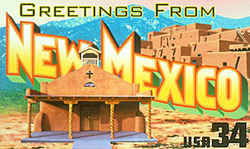
New Mexico Symbols
New Mexico State Grass
Blue Grama Grass

(Bouteloua gracilis )
Adopted in 1973.
The blue grama, (Bouteloua gracilis,) is a low-growing, six-to- 12-inch-tall warm season perennial sod or bunch grass. Its seed stalks, with two comb-like purplish spikes on each side, occasionally grow as high as four feet.
The blue grama is found in all areas of New Mexico, but especially on sand, loam, shallow sites, bottomlands and mountain grasslands, mostly between 3,000 and 8,000 feet.
The blue grama was adopted as the official state grass in 1973 by the state legislature.
New Mexico State Grass: Blue Grama Grass

General Culture:
Easily grown in average, dry to medium wet, well-drained soils in full sun. Tolerates a wide range of soils, except poorly-drained, wet ones. Excellent drought tolerance. Freely self-seeds. Cut to the ground in late winter before new shoots appear.
Characteristics:
Blue grama grass is a clump-forming Missouri native grass which is typically found in dryish soils on upland prairies and along railroad tracks. It is an important component of the short grass prairies of the Great Plains. A diminutive species of grass which features narrow leaf blades and unique flower spikes which are attached at right angles to the stems and resemble mosquito larvae. Flowers bloom reddish purple in summer on stems rising above the foliage to 20" tall. At frost, foliage turns purplish then tan. Also commonly called mosquito grass.
Uses:
Small size makes blue grama grass an excellent selection for rock gardens where it can be used as a specimen or in small groups. Also an excellent choice for naturalized areas, native plant gardens, unmowed meadows, prairie areas or other informal areas in the landscape, especially where drought tolerant plants are needed. Can also be grown as a turf grass and regularly mowed to 2 inches high.
New Mexico Law
The law designating the blue grama grass as the official New Mexico state grass is found in the 2013 New Mexico Statutes, Article 3, Section 12-4-4 H.
Chapter 12 - Miscellaneous Public Affairs Matters
Article 3 - State Seal, Song and Symbols
Section 12-3-4 - State flower; state bird; state tree; state fish; state animal; state vegetables; state gem; state grass; state fossil; state cookie;
state insect; state question; state answer; state nickname; state butterfly; state reptile; state amphibian; state amphibian; state aircraft; state
historic railroad; state tie; state necklace.
Universal Citation: NM Stat § 12-3-4 (2013)
12-3-4. State flower; state bird; state tree; state fish; state animal; state vegetables; state gem; state grass; state fossil; state cookie; state
insect; state question; state answer; state nickname; state butterfly; state reptile; state amphibian; state aircraft; state historic railroad; state
tie; state necklace. (2011)
A. The yucca flower is adopted as the official flower of New Mexico.
B. The chaparral bird, commonly called roadrunner, is adopted as the official bird of New Mexico.
C. The nut pine or pinon tree, scientifically known as Pinus edulis, is adopted as the official tree of New Mexico.
D. The native New Mexico cutthroat trout is adopted as the official fish of New Mexico.
E. The native New Mexico black bear is adopted as the official animal of New Mexico.
F. The chile, the Spanish adaptation of the chilli, and the pinto bean, commonly known as the frijol, are adopted as the official vegetables of New
Mexico.
G. The turquoise is adopted as the official gem of New Mexico.
H. The blue grama grass, scientifically known as Bouteloua gracillis, is adopted as the official grass of New Mexico.
I. The coelophysis is adopted as the official fossil of New Mexico.
J. The bizcochito is adopted as the official cookie of New Mexico.
K. The tarantula hawk wasp, scientifically known as Pepsis formosa, is adopted as the official insect of New Mexico.
L. "Red or green?" is adopted as the official question of New Mexico.
M. "Red and green or Christmas" is adopted as the official answer of New Mexico.
N. "The Land of Enchantment" is adopted as the official nickname of New Mexico.
O. The Sandia hairstreak is adopted as the official butterfly of New Mexico.
P. The New Mexico whiptail lizard, scientifically known as Cnemidophorus neomexicanus, is adopted as the official reptile of New Mexico.
Q. The New Mexico spadefoot toad, scientifically known as Spea multiplicata, is adopted as the official amphibian of New Mexico.
R. The hot air balloon is adopted as the official aircraft of New Mexico.
S. The Cumbres and Toltec scenic railroad is adopted as the official historic railroad of New Mexico.
T. The bolo tie is adopted as the official tie of New Mexico.
U. The Native American squash blossom necklace is adopted as the official necklace of New Mexico.
History: Laws 1927, ch. 102, § 1; C.S. 1929, § 129-101; 1941 Comp., § 3-1303; Laws 1949, ch. 142, § 1; 1953 Comp., § 4-14-3;
Laws 1955, ch. 245, § 1; 1963, ch. 2, § 1; 1965, ch. 20, § 1; 1967, ch. 51, § 1; 1967, ch. 118, § 1; 1973, ch. 95, §
1; 1981, ch. 123, § 1; 1989, ch. 8, § 1; 1989, ch. 154, § 1; 1999, ch. 266, § 1; 1999, ch. 271, § 1; 2003, ch. 182, §
1; 2005, ch. 4, § 1; 2005, ch. 254, § 1; 2007, ch. 10, § 1; 2007, ch. 179, § 1; 2011, ch. 52, § 1.
Taxonomic Hierarchy: Blue Grama Grass
Kingdom: Plantae - Plants
Subkingdom: Tracheobionta - Vascular plants
Superdivision: Spermatophyta - Seed plants
Division: Magnoliophyta - Flowering plants
Class: Liliopsida - Monocotyledons
Order: Cyperales -
Family: Poaceae - Grass family
Genus: Bouteloua Lag. - grama
Species: Bouteloua gracilis (Willd. ex Kunth) Lag. ex Griffiths - blue grama







